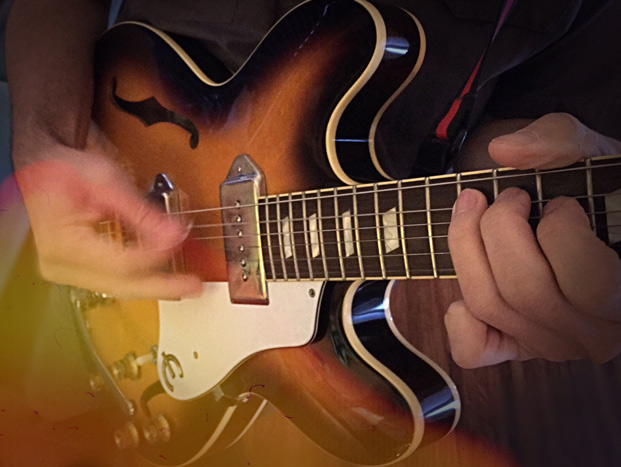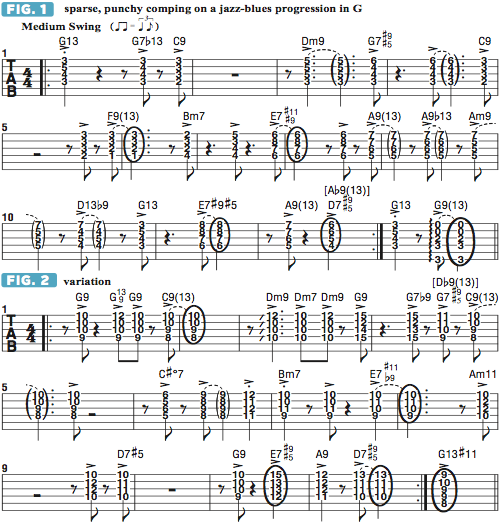Jazz-Blues Comping with "Chord Jabs"
Learn a jazz guitar comping technique that provides interesting chord movement and rhythmic “push.”

Continuing our exploration of cool things to do with a jazz-blues chord progression in a rhythm section, I’d now like to demonstrate an accompaniment, or “comping,” technique favored by jazz guitarists, pianists and organists alike over a swing-style walking bass line (provided by a bassist, second guitarist or keyboardist’s left hand) that provides interesting chord movement and rhythmic “push” while remaining texturally light and unobtrusive and not crowding out a soloist or “stealing the spotlight.”
The concept is to think like a big-band arranger and play like a tightly orchestrated horn section, sparsely interjecting punchy, staccato chord accents, also known as “jabs,” or “stabs,” into the groove using swing-eighth rhythms but doing so sparingly, so as to give the soloist plenty of open space in which to improvise and the bassist and/or drummer ample room to “play time.”
The technique builds upon examples I presented in the previous two columns (see String Theory August and September 2016), in which I played walking bass lines with chord stabs added. Now we’ll let the bass player do the walking, which will free up our hands to play bigger, bolder chord voicings and more varied rhythms.
FIGURE 1 has us comping on a 12-bar jazz-blues progression in the key of G, using four-note voicings on the top four strings exclusively, except for the final chord. Again, the concept is to emulate a group of synchronized horns. You could strum each chord with a pick, but you’ll achieve a more precise, non-staggered articulation by employing hybrid picking or straight fingerpicking, using either the pick or your bare thumb to play the notes on the D string and your middle finger, ring finger and pinkie to pluck the top three strings.
One of the creative challenges with this comping style is to try and vary your rhythms enough so that they sound fresh, as it’s all too easy to fall into a repetitive, predictable phrasing pattern. Notice that many of the chord jabs fall on an eighth-note upbeat—on one of the “and” counts between beats—and half a beat “early,” relative to when the chord change “officially” occurs. These anticipations create a strong sense of forward motion, which helps propel the groove. Many of the chords are separated by rests, or “holes of silence,” of varying lengths while other chords are tied over and held into the following beat. Sustained notes and chords provide a welcome contrast to short rhythms.
FIGURE 2 offers another example of the same comping approach applied to a slightly different set of changes (there are quite a few variations on the jazz-blues progression), with a few substitutions employed and featuring some new, interesting voicings and rhythmic motifs. As you play through both figures, listen to and study the voice-leading from chord to chord, meaning the way in which each individual note, or voice, moves up or down, or remains stationary, as a common tone, in relation to the voices on the other strings. Also notice that a couple of chords have an alternate name (indicated in brackets), which is what that chord would be called if a bassist were to play a tritone-substitution root note beneath it, something jazz musicians love to do when walking.
One of the coolest and most intriguing things about jazz is the way individual musicians, when jamming on a chord progression and improvising, will creatively interject tritone subs and other types of chord substitutions, be they diatonic (key-based) or non-diatonic (chromatic), or superimpose or melodically imply them over what others might be playing. This makes for unpredictable “outside” dissonances and a fluid musical push-pull of tension and release, which can be quite exciting and dramatic.

Get The Pick Newsletter
All the latest guitar news, interviews, lessons, reviews, deals and more, direct to your inbox!
Over the past 30 years, Jimmy Brown has built a reputation as one of the world's finest music educators, through his work as a transcriber and Senior Music Editor for Guitar World magazine and Lessons Editor for its sister publication, Guitar Player. In addition to these roles, Jimmy is also a busy working musician, performing regularly in the greater New York City area. Jimmy earned a Bachelor of Music degree in Jazz Studies and Performance and Music Management from William Paterson University in 1989. He is also an experienced private guitar teacher and an accomplished writer.










![Joe Bonamassa [left] wears a deep blue suit and polka-dotted shirt and plays his green refin Strat; the late Irish blues legend Rory Gallagher [right] screams and inflicts some punishment on his heavily worn number one Stratocaster.](https://cdn.mos.cms.futurecdn.net/cw28h7UBcTVfTLs7p7eiLe.jpg)
